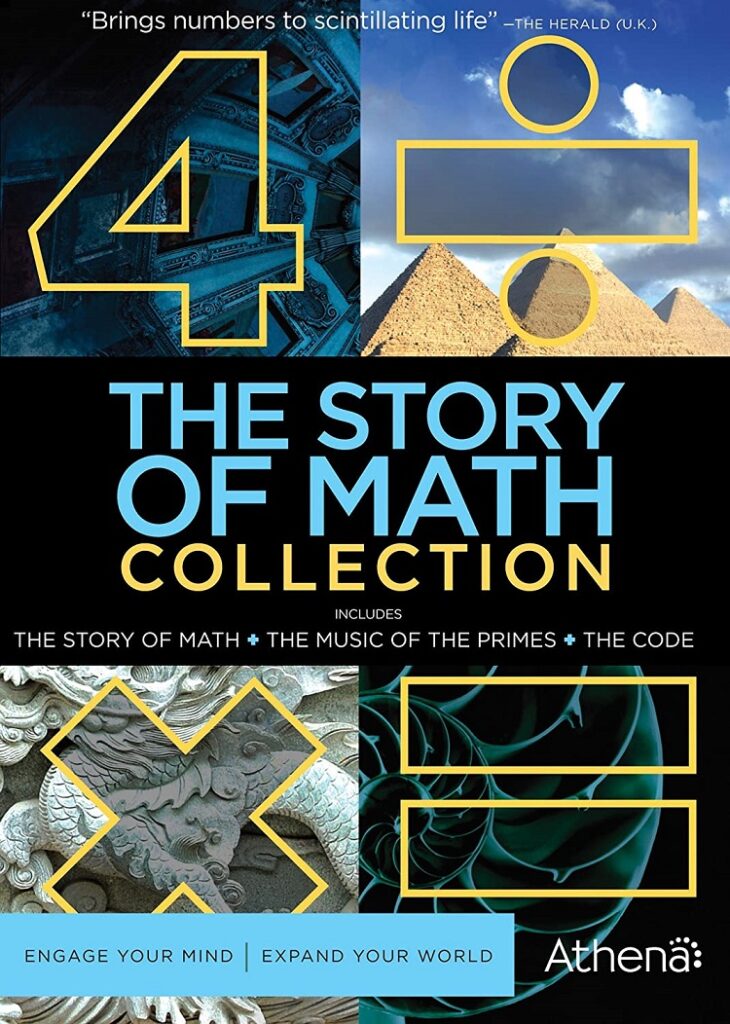
I would like to preface this review by mentioning that I was about as far from being a “math-lete” in school as one could possibly imagine. If I were able to go back in time and tell the ninth-grade me that one day I would have willingly watched an eight-hour program about math, I probably would have ended it all right then. That is how much I hated geometry. Yet all these years later, I have not only watched said program, but actually enjoyed every minute of it.
The Story of Math Collection is a five-DVD set, hosted by noted mathematician Marcus du Sautoy. Like just about everything I have had the pleasure to watch from the Athena Learning Company, The Story of Math Collection is informative, fascinating, and above all, highly entertaining. Who knew math could be so fun?
The Story of Math is a triple-DVD set, with four one-hour episodes, plus the 78-minute bonus feature “The Music of the Primes.” The individual programs are “The Language of the Universe,” “The Genius of the East,” “The Frontiers of Space,” and “To Infinity and Beyond.” Over the course of the set, du Sautoy takes us from the very first discoveries in the field, all the way up to the present, and beyond.
“The Language of the Universe” begins in 1800 BC, in ancient Babylon and Egypt. The demands of civilization are what propelled the first insights. Mr. du Sautoy offers a wide range of examples of how the demands of organizing a society contributed to the understanding of the world of numbers. This is all highly interesting material, but what really blew me away were the stone textbooks that have been found from the era. Children literally lugged these tablets home to do their homework, and I found it absolutely amazing that some of these have survived for nearly 4,000 years.
“The Genius of the East” takes us out of the Middle East and into China. Once again, the sociological challenges of the time pushed the study of numbers along. In this case it was in regards to the Chinese Empire. Another interesting bit of information about the early Chinese and numbers is just how deeply spiritual the relationship was. The concept of numerology was very important to their society, in addition to the practical aspects. The program winds up in the West, with discussions of the important Greek mathematicians, including Pythagorus and Euclid.
Things had moved along considerably by the 17th century, where “The Frontiers of Space” begins. The advances include the development of calculus by Sir Isaac Newton and the stretching of geometry to describe three-dimensional space. In what would prove to be a vital stepping stone to the invention of the computer, Carl Friedrich Gauss invented modular arithmetic in the late 18th century.
The fourth episode of the series is “To Infinity and Beyond.” This is literal, as the program begins with a discussion of the German mathematician Georg Cantor’s explorations of the concept of infinity in the early 20th century. In trying to determine whether the planets in the solar system have stable orbits, Henri Poincare laid out the foundations of what we came to know as “chaos theory” around this time also.
“To Infinity and Beyond” could have been subtitled “Everything You Know is Wrong.” After centuries of dedicated study to determine the facts, what is becoming more and more apparent is the element of chaos and uncertainty in the universe. It appears that random chance is an essential component of our world, which certainly raises more questions than it answers. One could say that the story of math has only just begun.
“The Music of the Primes” is the bonus feature and is an excellent program in its own right. Prime numbers have fascinated mathematicians since Euclid’s time, and this show explores the many intriguing theories about them. I found the three-dimensional graph created by Bernhard Riemann to be one of the more intriguing subjects brought up here. The graph describes a landscape in which zeros occur in a regular pattern precisely on a line that extends to infinity. He proposed that this distribution shows the pattern of prime numbers. Although the hypothesis remains unproven, most mathematicians now accept it as true.
There are a few more bonus pieces included in this set as well. They include three Math Shorts, each running four minutes: “Phi’s the Limit,” “Go Forth and Multiply,” and my favorite, “Imagining the Impossible: The Mathematical Art of M.C. Escher.”
The real bonus of The Story of Math Collection is the inclusion of the previously released two-DVD series The Code, which I previously reviewed. This is an excellent three-part program and is again hosted by du Sautoy.
The box set also includes informative booklets for each series, plus online links for further discussion. Taken together, The Story of Math Collection opens up the marvelous world of numbers in ways I never thought possible. Athena’s motto is “Engage Your Mind, Expand Your World,” and The Story of Math Collection offers us an excellent opportunity to do just that.